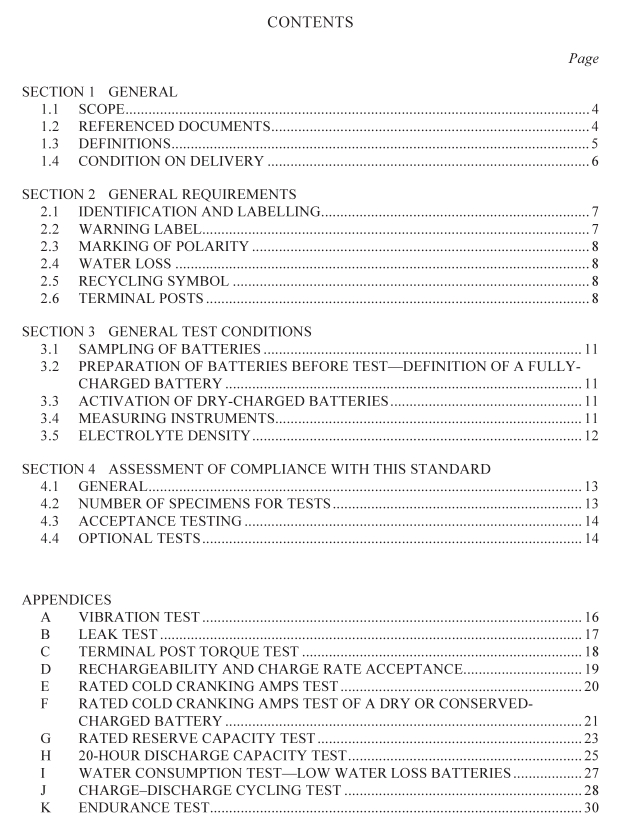AS 2149 pdf download – Starter batteries—Lead acid

AS 2149 pdf download – Starter batteries—Lead acid
1.3.2 Charge acceptance
The current I ca that a partially discharged battery takes up at 0°C and at constant voltage of 14.4 V.
1.3.3 Charge retention
The cold cranking performance of a charged and filled battery after storage on open circuit under defined conditions (temperature, time).
1.3.4 Conserved-charged battery
A battery that when supplied contains only a small quantity of electrolyte, mainly absorbed within the plates and separators. The plates are in a charged condition and the battery is activated by the addition of further electrolyte.
1.3.5 Dry-charged battery
A new battery may be designated as dry-charged if it can be activated, ready for service, by filling it with the specified electrolyte and in accordance with any specific instructions from the manufacturer.
1.3.6 Electrolyte retention
The ability of a battery to retain electrolyte under specified mechanical conditions.
1.3.7 Endurance in cycles
The ability of a battery to perform repeated discharge/recharge cycles and long rest periodson open circuit.This ability is tested by a series of cycles and rest periods under specifiedconditions after which the cold cranking performance is determined.
1.3.8 Rated cold cranking amps (CCA)
The discharge current to be shown by the manufacturer that a battery can supply at -18Cfor 30 s to a minimum voltage Ur= 7.2 v (i.e.1.2 V per cell).
1.3.9 Valve-regulated cell
A cell which is closed under normal conditions but which has an arrangement which allowsthe escape of gas if the internal pressure exceeds a predetermined value.Electrolyte is notnormally added to a valve-regulated cell.
1.3.10 Vented (flooded) cell
Either—
(a)a secondary cell having a cover provided with an opening through which gaseous
products can escape and providing access to the electrolyte through which electrolytemay be added; or
(b)
a secondary cell having a cover provided with a venting system through whichgaseous products can escape but with no access to the electrolyte.
NOTE:This opening may be fitted with a venting system.
1.3.11 Vibration resistance
The ability of a battery to maintain service under acceleration forces.1.4CONDITION ON DELIVERY
New batteries may be supplied in one of the following states:
(a)In a state ready for use, filled with the appropriate electrolyte to the maximum level.
After an initial charge (according to Clause 3.2), the electrolyte density or oCV shallbe within the ranges specified in Clause 3.5; or
(b)
In a dry-charged state not filled with electrolyte. The density of the electrolyte to fillsuch batteries before use shall be in the range 1250 kg/m3to 1280 kg/m3at 25°cunless otherwise specified by the manufacturer.
2.1 IDENTIFICATION AND LABELLING
Batteries shall be marked with the following information:
(a) The name or registered trademark of the manufacturer or supplier, or of both the manufacturer and supplier.
(b) The address of the manufacturer or supplier whose name, trade-name or trademark is given under (a) above.
(c) The rated cold cranking amps, in amperes for starter batteries (see Clause 1.3.8).
(d) The rated reserve capacity, in minutes for starter batteries (see Clause 1.3.1).
(e) The 20-hour capacity for deep cycling batteries (see Clause 1.3.1)
(f) The maximum recharging voltage that can safely be applied to the battery.
The information required by Item (b) may be omitted, if the manufacturer or supplier has offices or agents in every State and Territory of Australia and if the omitted information is available from catalogues or similar publications.
All markings and labels shall be legible and durable for the expected service life of the battery.
2.2 WARNING LABEL Batteries shall carry a warning label as shown in Figure 2.1 and a warning label including the following advisory statement or words that clearly convey that meaning, pointing out the explosive hazard associated with the process of charging batteries and the corrosive contents of the battery: WARNING: Lead-acid batteries generate explosive gases. Keep sparks, flames, and lighted cigarettes away from battery, when charging or using battery in an enclosed space, provide ventilation. This battery contains sulphuric acid. Avoid contact with skin, eyes or clothing. In event of accident flush with water and call a physician immediately. The warning label shall be prominently displayed on the battery in a position that is not likely to be hidden from view when installed in a vehicle. The wording shall be in contrasting colours to the background. The word WARNING shall be written in letters having a minimum height of 3 mm. The text of the label shall have letters with a minimum height of 2 mm.









